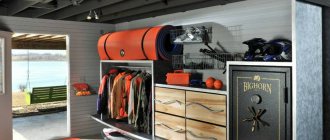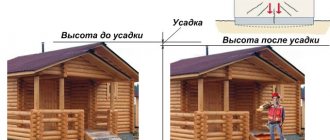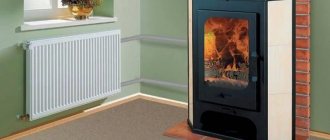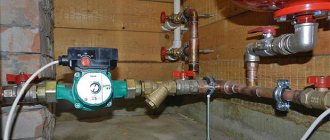Energy prices are steadily rising, so an increasing number of suburban residents are thinking about how to inexpensively and efficiently heat their homes. Most often, homeowners are concerned about what heating options are available for a private home and country house, which boiler has the highest efficiency, which boiler to choose for the heating system, how to properly install the heating system, what types of heating without gas exist and which ones are the most economical.
FORUMHOUSE advises a different approach. First, we decide on the type of fuel, and then we select a heating system “for it.”
From our material you will learn:
- What are the costs of a heating system?
- What type of fuel can be called the most affordable;
- What does a convenient heating system mean?
- Can heating with electricity be cheap?
- What can become the basis of an economical heating system.
What are the costs of a heating system?
Many factors influence how much a particular heating method will cost. Only after calculating all the costs (it is also necessary to take into account the increase in fuel prices in the long term) can you decide on the most cost-effective heating method. To do this, you need to consider:
- Fuel cost;
- The cost of its delivery;
- Cost of heating equipment;
- The cost of its installation;
- Costs of its operation;
- Average monthly air temperature in winter;
- Method of living in the house: “dacha” mode or permanent residence;
- Availability of utilities connected to the site (gas, required electrical power);
- The degree of insulation and energy efficiency of the home.
When thinking about choosing a heating system and considering different heating options in the house, first of all you need to answer the question: not “how”, but “with what” you will heat your home. It is the type of fuel, its cost and availability that determines the cost of heating. season.
Let's consider the following situation: there is currently no main gas, as a more economically advantageous type of fuel, or its connection will be too expensive. What to do in this situation, what type of fuel to choose: firewood, liquefied gas, coal, pellets, fuel briquettes, electricity, even solar panels - there are a lot of options. Let's see which type of energy carrier is most preferable.
How to connect gas to a house is described in detail in this article.
The approach is usually the following: which energy carrier is most available in a region or a specific area is chosen. If there is a forest nearby, then they choose firewood. Coal mine - coal. We have access to cheap diesel fuel - we install a diesel boiler. There is no need to “sort through” all the possibilities and all the options for heating the house - we settle on the most affordable one.
This seems logical, but when choosing the most rational type of fuel, you need to think about how it will be used. It may turn out that the complexity of using fuel, the high cost of installing equipment, delivering and storing energy, outweigh the benefits of its use.
Heating options for a private home
Only by weighing the pros and cons and comparing several types of fuel can you come to a common denominator. No matter how cheap coal or firewood is, few people will be happy with the prospect of becoming a fireman (and coal is also constant dirt in the boiler room) or getting up in the middle of the night and throwing firewood into the firebox of a solid fuel boiler.
Pellet boilers (depending on the volume of the loading hopper) can operate for several days without the need for manual loading, but pellets are not common in all regions. Also, depending on the batch, their quality may be poor.
Such types of fuel as: pellets, firewood, coal, diesel fuel, liquefied gas require arrangement of storage space. In small areas it is difficult to find a place for a gas holder to organize heating of the house with gas; or a wood storage facility where you can stock up on fuel for the entire heating season, which lasts 6-8 months. The heating value of firewood or pellets can be significantly reduced if they become damp during storage.
Here we talk about all the possible heating options for a private home.
Such nuances have a significant impact on creating an economical heating system for a country house. Let's try to formulate the basic requirements for such a system. Cheap heating is:
- A system that uses the type of fuel available and convenient for you ;
- A system that is inexpensive to operate;
- A system that intelligently uses the received thermal energy (heat is accumulated due to the increased thermal inertia of the structural elements of the house). This could be a heated floor system, concrete screeds, USHP foundation, heat accumulators, etc.
To understand what advantages are inherent in the water heated floor system, we will turn for clarification to the head of the technical department of the “Engineering Systems” direction of the REHAU Sergei Bulkin, Moscow.
Sergei Bulkin
The water heated floor system can be used both as main and additional heating. It has a number of advantages over traditional radiators. Among them we can note - efficiency, ease of use, increased thermal comfort. Because water heated floors provide radiant heat, which is most comfortably perceived by the human body.
The heat emanating from the floor rises and is evenly distributed throughout the entire volume of the room. Therefore, the most favorable heating scheme for a person is created in the room - “feet are warm, but head is cold.”
The basis of such a system is a network of heating pipes (concreted in the floor screed) through which the coolant circulates - hot water or antifreeze (ethylene or propylene glycol). This system is not suitable for reconstruction in residential multi-apartment buildings with existing radiator wiring - its installation in them is prohibited by law. Since this leads to additional load on the floor from the heating screed and imbalance of the heating system of the house.
In order to get the maximum effect from a water heated floor system, its design must be carried out in advance, with individual reference to a specific house, and with mandatory thermal and engineering calculations.
Adviсe
The choice of suitable fuel is influenced by the total area and level of energy efficiency of the house, the average temperature and length of the heating season, access to energy resources and tariffs, as well as restrictions on the allocated electricity capacity for private needs.
“If none of the proposed options has a clear superiority over the others, then you can resort to combining them. Meanwhile, under equal conditions, the optimal solution would be to use main gas, despite the impressive investments at the initial stage. If it is not possible to connect to the gas pipeline, then the most rational option for larger houses would be to install a gas holder, while for smaller areas gas cylinders are sufficient. Electricity is a convenient option, but if there are no incentives to pay for it, then in the end it will be the most expensive heating method, despite the minimal cost of connection,” advised Viktor Timokhin.
The bar chart compares the relative cost of the initial investment and subsequent maintenance of popular heating sources. The data applies to an insulated country house with an area of 150 square meters. m in the Moscow region with a heating season from October to May. Compiled and sent by Viktor Timokhin
What type of fuel can be called the most accessible and cheapest?
A dispute often arises as to which fuel is the cheapest in the absence of mains gas. We are looking for the cheapest heating without gas based on the experience of our forum users.
ArtashirFORUMHOUSE user
I decided to make an approximate calculation of the costs of operating different types of heating equipment over a period of 15 years, including the cost of energy, for the following heating systems:
- gas (gas boiler);
- heating with wood;
- heating using wood pellets;
- electric (electric boiler).
The forum member used the following as initial data:
- Residential building area - 100 sq.m;
- The duration of the heating period is 8 months;
- The average power of equipment during the heating period (efficiency) is 50%;
- Specific power of the climatic zone is 1.5 kW (Khanty-Mansiysk Autonomous Okrug - Yugra).
Hot water supply and gas stove are not taken into account in the calculations.
And this is what happened.
As can be seen from the tables presented, the most expensive heating is electricity at a daily rate. The cheapest is main gas, solid fuel is in the middle of this rating. It is also necessary to familiarize yourself with the results of a similar calculation by a user of our site under the nickname bkostik.
BkostikFORUMHOUSE user
I made calculations in relation to St. Petersburg.
As can be seen from the table, heating with diesel fuel and bottled gas is one of the most expensive, but heating with electricity, when using the night tariff, is not so expensive. However, this does not mean that everyone can install an electric boiler for themselves, because... Not in all settlements the required power can be allocated to a house. In order for heating a house without gas, with electricity alone, to be truly profitable, a number of conditions must be met. Namely:
The house must be well insulated;
- Heat loss through building envelopes (walls, floors, roofs) as well as windows and doors should be minimized;
- A heat accumulator is required.
Heat pump
A heat pump can probably be called the most convenient and expensive alternative energy source. It saves electricity, is environmentally friendly and has a high installation efficiency. Although it has been known for a long time, the heat pump has not yet found widespread use.
“One of the limiting factors is the technically complex setup and high cost of the geothermal system, the payback period of which is from 5 years. Therefore, it is difficult to consider a heat pump as a common energy source. Although it is very convenient, it can work as a source of heat in winter and for cooling in summer,” explained Victor Timokhin.
According to him, installing a heat pump will require over 600 thousand rubles, but in the future about 6 thousand will be spent on heating per month.
conclusions
They are disappointing. A cheaper alternative to gas heating that will work in any climate is a myth. At current gas prices, it remains the most profitable source of heat. But his prospects, alas, are gloomy: gas prices will quickly rise, and the price ratio may yet change towards electricity.
Let us repeat - this is far from the only point of view. The video at the end of the article covers this topic differently; You will probably be interested in hearing another position. Warm winters!
Today, natural gas is the most popular and affordable type of fuel for domestic needs and heating. However, fossil reserves are not unlimited, the cost of gas is rising, and connecting to the main line is often impossible or insanely expensive. This forces us to look for other, less conventional ways to heat our homes.
Diesel fuel
Diesel oil is another type of fuel used to heat a home. Its specific heat of combustion is about 10,180 kcal/kg or 8,650 kcal/l (taking into account the average density of the liquid, which differs between winter and summer diesel engines).
The efficiency of a diesel fuel boiler is about 90%. The retail price of one liter of diesel fuel is about 28.5 rubles, respectively, 1 Gcal will cost 3,650 rubles, which means that organizing heating using diesel fuel is a rather expensive undertaking. In addition, the cost of diesel fuel is unstable; its price has risen sharply more than once recently.
Capital investment and equipment support
The costs of connecting an electric boiler “from scratch” are insignificant compared to gas-fired equipment. It can be installed in any free space, even in a residential area.
Powerful electric boilers operate on 380 V. Therefore, when installing such equipment, you will have to spend money on a three-phase connection at home
Installing gas equipment is much more difficult and expensive, as you will have to complete the following steps:
- Obtain technical specifications from your local gas supply organization. You must indicate the estimated gas consumption.
- Organize a separate place for the boiler with sufficient ventilation. Acceptance of the boiler before starting its operation and an annual safety check will be carried out by a specialist from the gas company.
- Lay gas communications in the premises. To avoid problems with acceptance, it is better to have this done by a gas company specialist.
- Set up a system for removing combustion products.
When choosing a system that runs on liquefied gas, you need to organize the installation of a gas holder, since heating the house with cylinders will be very expensive. In addition, you will often have to refill the cylinders, so the heating process can hardly be called automatic.
For small houses and warm regions where gas consumption for heating is insignificant, you can combine several cylinders using a ramp, but this solution is also less economical than even a small-volume gas holder.
The gas holder can be installed in a pit excavated from any side of the house. The communications connected to it will not be visible and will not interfere with the construction of the lawn. However, it is impossible to place beds and household buildings above the equipment and pipelines - it is necessary to maintain the ability to monitor the condition of the system, maintain and repair
Designing and connecting to the gas main also requires significant funds. The price for this service depends on the region of residence and the topology of the site on which the cottage stands.
On average, the estimate, installation of a gas pipeline from the outlet to the gas consumer and putting the site into operation can cost from 80 to 300 thousand rubles.
Metal furnaces
Once upon a time they were called potbelly stoves. This name dates back to the distant times of the civil war and subsequent devastation, when the simplest joys of life were associated with great wealth.
Much has changed since then, but an iron stove is still called a potbelly stove. They look different now. Many of them are equipped with fireproof glass windows, but their essence has not changed - they heat up quickly and cool down just as quickly.
Maybe that’s why this stove was called a potbelly stove, because maintaining a constantly high temperature requires a lot of wood, bourgeois style.
Folk fantasy
In the Siberian taiga huts, where it is possible to install a cast-iron stove, but it is difficult to deliver bricks, the potbelly stove is lined on three sides with large stones, rolled in by the river. It turns out beautiful and functional - the stones heat up and slowly release heat to the air.
This technique is quite applicable in the conditions of a country house - when the house is built, but the heating is not yet ready. To some extent, stones perform fire-fighting functions, absorbing random sparks and excess heat. Stone structures can serve as a reason for the designer’s flights of fancy.
The efficiency of a metal stove will increase if you equip it with a coil for heating water and connect heating batteries to it.
Method 1 - electric convectors
With the help of electric convectors it is possible to provide a cheap and efficient heating system. The electric convector is built on the principle of natural air circulation. Warm air moves upward from the heater, thus stimulating the movement of air inside the room and ensuring uniform heating. However, a convector is effective only in warm climates, when the temperature does not fall below 10-15 degrees.
pros
- No forced air blowing. Even in the cleanest home there are particulates that lie on surfaces. When warm air is artificially blown out of a heater, this dust becomes part of the air we breathe. Natural air circulation is not so active, so dust does not rise into the air.
- Small size with sufficient power. The heating elements of convectors heat up quickly, converting electricity into heat with an efficiency of up to 80%. In addition, there is a system of operation in different modes, as well as thermostats that allow operation not constantly, but only when the air temperature drops.
- Mobility, allowing you to move the convector around the room, to places with maximum cold flow.
- The possibility of creating a heating system exclusively using convectors or using them as part of a more complex heating system.
- The electric heating element does not heat up more than 100 degrees, and the body - 60 degrees. They have an increased level of protection from moisture, which allows the convector to be used in the kitchen and bathrooms.
Minuses
- The disadvantage of electric convectors is the installation of heaters in every room of the house.
- In addition, if you turn them on at the same time, there is a possibility of exceeding the permissible power limits.
The photo shows an electric convector from Nobo, Norway
Liquefied gas
Liquefied gas is transported and stored in cylinders or gas holders, specially designed for this purpose
In order to heat a country house, you can purchase liquefied gas cylinders. It is based on a propane-butane composition. Heating a country house with liquefied gas is noticeably more expensive than natural gas, but often cheaper than diesel fuel and electricity. The cost is reduced if a large capacity storage facility with appropriate equipment is installed for several homes.
There are no fundamental differences in the design of heat-generating equipment for natural and liquefied gas: conventional boilers are used, the only difference is in the adjustment: the pressure in the gas pipeline is lower. In some cases, it will be necessary to replace the jets in the burners; this is inexpensive and the equipment can be quickly returned to its original condition.
A gas holder is a container used to store liquefied gas in large quantities. Such tanks are installed both on the surface of the earth and underground. Most often, for country houses, they choose the underground option of installing a gas tank in order to save space and money. The depth of its occurrence must be no lower than the freezing level of the soil.
In Western European countries, gas tank systems are used quite widely; in our country, the liquefied gas delivery service is underdeveloped and is not available everywhere. For small houses, you can also use groups of standard liquefied gas cylinders. True, their capacity is too small to ensure the operation of the boiler for a long time; frequent replacement, taking into account transport costs, can make operating the system on cylinders more expensive than heating with diesel fuel. For a small dacha, we can recommend using bottled gas with a convector. But only with strict adherence to fire safety measures!
Solid fuel boiler
A solid fuel boiler with automatic fuel supply is one of the best options for heating a house without gas.
True, our pellets are inferior in quality to European ones; they have a higher ash content and moisture content. The last parameter can reach 15% - this is due to unsatisfactory storage conditions. In this regard, the calorie content of this fuel may differ from that stated by the manufacturer.
In addition, pellets are not yet so widespread, which means that in the absence of competitors, the manufacturer or supplier can dictate their terms and inflate the price.
When purchasing a universal boiler with replaceable burners that allow you to operate on gas and diesel fuel, you will have to pay about 50 thousand rubles, which means that the difference with a pellet boiler will pay off in 4-5 years. In the event of a temporary lack of gas (the project involves the installation of a gas pipeline in the coming years), it is much more profitable to purchase a universal boiler than to use pellets.
Classic stove heating
In certain cases, a stove is the only possible way to organize heat in the house
Stove heating is considered the oldest. Stove heating is still often used in suburban buildings. Don't think that this method is outdated. The lack of gas in some regions leaves this type of heating still very popular and in demand. Combination stoves remain in fashion, allowing both heating a room and cooking food. Among the advantages of this option are savings on installation, operation, fuel, and versatility. With all this, stoves need to be heated several times a day; they require constant maintenance. In addition, the risk of fire is high; ovens are quite large and take up a lot of space. The room in which the stove is located is always contaminated with soot and coal, and will also require constant cleaning and regular maintenance. There is a high risk of carbon monoxide poisoning if the stove is used incorrectly.
Ease of use
The operation of modern boilers, regardless of the type of fuel, is not difficult.
Ease of maintenance and use is an important characteristic. The consumer pays extra for convenience.
Electric boiler
The device is equipped with a control module and multi-stage automatic safety system. The setup is extremely simple and is carried out by the consumer himself. If the device is equipped with a programmer, you can also set the operating mode - for example, reducing power at night, on and off times, etc.
Gas holder
Operating the gas tank itself is also not difficult. The tank operates in automatic mode. The owner periodically checks the fuel level using the sensor and, if necessary, buys a gas mixture. The download is performed by the supplier.
To make the right decision, you need to evaluate all factors. For example, if elderly people live in a private house, electricity is preferable - it is safer. If there are interruptions in the supply of electricity, it is better to install a gas holder.
Solar collectors
An excellent alternative to gas heating is solar collectors. Such installations operate smoothly and economically. Collectors are ways to maintain heat in a room for a long time. But the main thing is that under good conditions they can generate electricity. Such installations have both their advantages and disadvantages.
Thus, solar collectors are absolutely safe. Installing such installations is quite simple and quick. Collectors are installed somewhere on the façade of a building. The installation will fit perfectly into the design of the house, since among a wide range you can choose the most suitable option for yourself. But most importantly, collectors provide significant savings in utility costs. Therefore, this type of installation is perfect even for low-income families.
The only drawback of such collectors is that they operate exclusively on solar energy. This determines the specifics of the installation of collectors. In regions where it is sunny almost all year round (usually the south of the country), installing collectors is completely justified. But in northern latitudes these installations will be completely useless.











